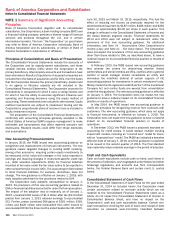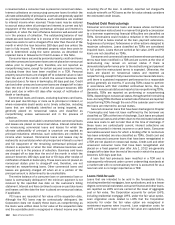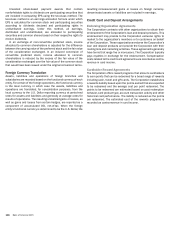Bank of America 2015 Annual Report Download - page 142
Download and view the complete annual report
Please find page 142 of the 2015 Bank of America annual report below. You can navigate through the pages in the report by either clicking on the pages listed below, or by using the keyword search tool below to find specific information within the annual report.140 Bank of America 2015
Under applicable accounting guidance, for reporting purposes,
the loan and lease portfolio is categorized by portfolio segment
and, within each portfolio segment, by class of financing
receivables. A portfolio segment is defined as the level at which
an entity develops and documents a systematic methodology to
determine the allowance for credit losses, and a class of financing
receivables is defined as the level of disaggregation of portfolio
segments based on the initial measurement attribute, risk
characteristics and methods for assessing risk. The Corporation’s
three portfolio segments are Consumer Real Estate, Credit Card
and Other Consumer, and Commercial. The classes within the
Consumer Real Estate portfolio segment are core portfolio
residential mortgage, Legacy Assets & Servicing residential
mortgage, core portfolio home equity and Legacy Assets &
Servicing home equity. The classes within the Credit Card and
Other Consumer portfolio segment are U.S. credit card, non-U.S.
credit card, direct/indirect consumer and other consumer. The
classes within the Commercial portfolio segment are U.S.
commercial, commercial real estate, commercial lease financing,
non-U.S. commercial and U.S. small business commercial.
Purchased Credit-impaired Loans
Purchased loans with evidence of credit quality deterioration as
of the purchase date for which it is probable that the Corporation
will not receive all contractually required payments receivable are
accounted for as purchased credit-impaired (PCI) loans. Evidence
of credit quality deterioration since origination may include past
due status, refreshed credit scores and refreshed loan-to-value
(LTV) ratios. At acquisition, PCI loans are recorded at fair value
with no allowance for credit losses, and accounted for individually
or aggregated in pools based on similar risk characteristics such
as credit risk, collateral type and interest rate risk. The Corporation
estimates the amount and timing of expected cash flows for each
loan or pool of loans. The expected cash flows in excess of the
amount paid for the loans is referred to as the accretable yield
and is recorded as interest income over the remaining estimated
life of the loan or pool of loans. The excess of the PCI loans’
contractual principal and interest over the expected cash flows is
referred to as the nonaccretable difference. Over the life of the
PCI loans, the expected cash flows continue to be estimated using
models that incorporate management’s estimate of current
assumptions such as default rates, loss severity and prepayment
speeds. If, upon subsequent valuation, the Corporation
determines it is probable that the present value of the expected
cash flows has decreased, a charge to the provision for credit
losses is recorded with a corresponding increase in the allowance
for credit losses. If it is probable that there is a significant increase
in the present value of expected cash flows, the allowance for
credit losses is reduced or, if there is no remaining allowance for
credit losses related to these PCI loans, the accretable yield is
increased through a reclassification from nonaccretable
difference, resulting in a prospective increase in interest income.
Reclassifications to or from nonaccretable difference can also
occur for changes in the PCI loans’ estimated lives. If a loan within
a PCI pool is sold, foreclosed, forgiven or the expectation of any
future proceeds is remote, the loan is removed from the pool at
its proportional carrying value. If the loan’s recovery value is less
than the loan’s carrying value, the difference is first applied against
the PCI pool’s nonaccretable difference and then against the
allowance for credit losses.
Leases
The Corporation provides equipment financing to its customers
through a variety of lease arrangements. Direct financing leases
are carried at the aggregate of lease payments receivable plus
estimated residual value of the leased property less unearned
income. Leveraged leases, which are a form of financing leases,
are reported net of non-recourse debt. Unearned income on
leveraged and direct financing leases is accreted to interest
income over the lease terms using methods that approximate the
interest method.
Allowance for Credit Losses
The allowance for credit losses, which includes the allowance for
loan and lease losses and the reserve for unfunded lending
commitments, represents management’s estimate of probable
losses inherent in the Corporation’s lending activities. The
allowance for loan and lease losses and the reserve for unfunded
lending commitments exclude amounts for loans and unfunded
lending commitments accounted for under the fair value option as
the fair values of these instruments reflect a credit component.
The allowance for loan and lease losses does not include amounts
related to accrued interest receivable, other than billed interest
and fees on credit card receivables, as accrued interest receivable
is reversed when a loan is placed on nonaccrual status. The
allowance for loan and lease losses represents the estimated
probable credit losses on funded consumer and commercial loans
and leases while the reserve for unfunded lending commitments,
including standby letters of credit (SBLCs) and binding unfunded
loan commitments, represents estimated probable credit losses
on these unfunded credit instruments based on utilization
assumptions. Lending-related credit exposures deemed to be
uncollectible, excluding loans carried at fair value, are charged off
against these accounts. Write-offs on PCI loans on which there is
a valuation allowance are recorded against the valuation
allowance. For additional information, see Purchased Credit-
impaired Loans in this Note. Cash recovered on previously charged-
off amounts is recorded as a recovery to these accounts.
Management evaluates the adequacy of the allowance for credit
losses based on the combined total of the allowance for loan and
lease losses and the reserve for unfunded lending commitments.
The Corporation performs periodic and systematic detailed
reviews of its lending portfolios to identify credit risks and to
assess the overall collectability of those portfolios. The allowance
on certain homogeneous consumer loan portfolios, which
generally consist of consumer real estate within the Consumer
Real Estate portfolio segment and credit card loans within the
Credit Card and Other Consumer portfolio segment, is based on
aggregated portfolio segment evaluations generally by product
type. Loss forecast models are utilized for these portfolios which
consider a variety of factors including, but not limited to, historical
loss experience, estimated defaults or foreclosures based on
portfolio trends, delinquencies, bankruptcies, economic
conditions and credit scores.
























